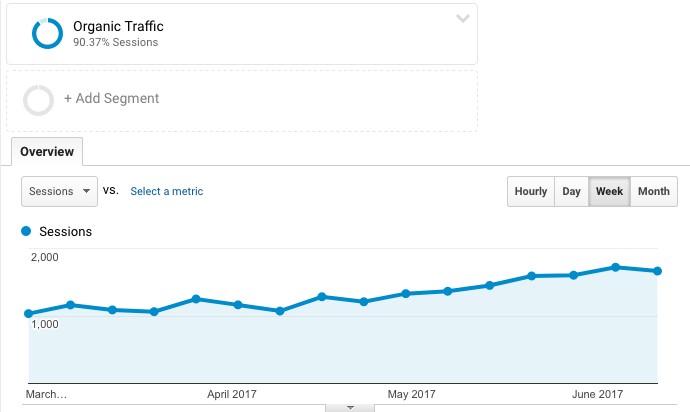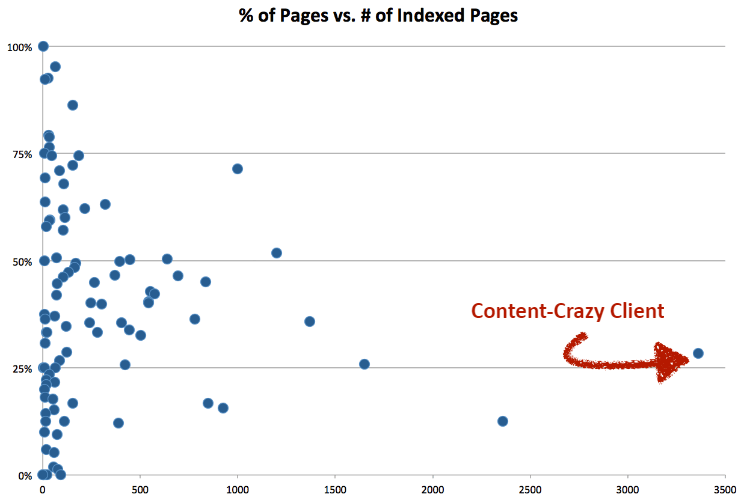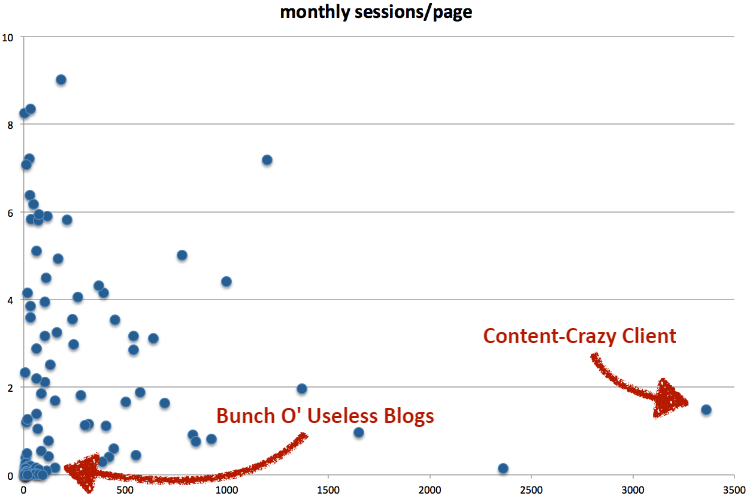More content, less traffic: Part II
Trying to determine whether it's worth your time to invest in ever more website content? Columnist Conrad Saam lays out a framework to help you decide.

At the end of last year, I shared the results from three of our projects showcasing how we had increased traffic by reducing a website’s overall page count. Simply put, many of our clients had way too much content — pages and pages of content that not only didn’t generate traffic, but also had the unintended consequence of hurting traffic sitewide by diluting keyword and topical relevance. By consolidating pages and reducing the total page count of these sites, we saw some dramatic improvements in overall traffic.
The purpose of this article is to lay out an analytical framework to answer an important question: How do I determine if I should continue to increase the content on my site?
First, I should note that I work in the hypercompetitive legal industry — and lawyers have been belching out web content at a stupendous rate after hearing time and time again that “Content is king” and that “Google likes fresh content.” Law firms around the country have hired small armies of low-end writers, outsourced content abroad and thinly plagiarized each other like mad. Long-tail legal content? Yup, we’ve got that in spades — search for a “lesbian car accident attorney” in any major city, and you’ll find not only pages optimized for that, but entire directories.
The reality is, there’s plenty of legal content out there — it’s really a matter of which legal content rises to the SEO surface.
My content-crazy client
In our most extreme example, we had a new client with a small team who had generated over 4,000 pages of domestically written, lawyer-reviewed, reasonably high-quality content. He had been at this for about three years and was averaging 25 new pages of content a month. Through some aggressive content pruning, we’ve cut about 40 percent of that content and seen dramatic, consistent improvement in their overall performance. Traffic has risen over 50 percent during the four months we’ve been at it.
The most difficult part for our agency was convincing the client to toss all of this work. After all, his content investment was substantial.
The framework for assessing IF you should continue investing in content is the same framework I used to convince him to stop burning his kid’s college fund on a tactic that wasn’t truly benefiting him.
Percentage of pages generating traffic
The most obvious approach is to calculate the likelihood that additional content will actually generate any traffic. To do this, I reviewed six months’ worth of SEO traffic.
First, I used Google Analytics to determine how many pages showed up in the Landing Pages Report with an Organic Segment overlay. This number is the numerator.
Next, I determined the overall page count; you can do this utilizing either Google Search Console OR a site: search to get the indexed count. That’s that denominator.
The resulting fraction represents the likelihood that a new page of content will actually generate traffic over a six-month period.
Now, you can take this to a much more sophisticated level. For example, not all content generates conversions at the same rate — in the legal industry, for example, blog traffic generates conversions at a much lower rate than practice area page traffic. But overall, this is a reasonable framework for answering the question, Should I be creating more content?
Back to our content-crazy client. In the graph below, he is represented by the data point at the far bottom right-hand side of the graph — almost 3,500 pages of content (about 15 percent of his content hadn’t even been indexed), each of which had about one chance in four of actually generating traffic. In order to dissuade our new client from continuing on his content addiction, I graphed him relative to all of our other clients. Your upside? I’m sharing those data points with you below to see where your own data falls.
In the graph above, you can clearly see that many law firm sites have way too much content, while a handful of our clients (at the top end of the graph) should be aggressively generating more content, as any individual page has a very high likelihood of generating more traffic.
Sessions per page
Another analytical lens through which to view the “Should I generate more content?” question is to calculate the average number of organic entry sessions per page. Essentially, if a page does generate traffic, how much traffic would that be?
Our content-crazy client is once again underperforming, averaging just over one session per page every six months. Also worth noting are the many lawyers that have started and failed with blog content, seduced by the promise of SEO silver bullets based on the “content is king” premise.
Getting down to business
To further dissuade my content-loving client from churning out yet more legal prose, I pushed the analysis into something more concrete: the number of months it would take for him to generate a new inquiry with his reliance on more and more content. Considering we’ve found that roughly 4 percent of organic sessions generate a business inquiry for law firms, and the client was barfing out 25 pages of content a month, we determined it would take roughly 17 months for this tactic to pay off in an incremental inquiry.
With those numbers in mind, the “more content” tactic starts to look truly ridiculous — and you can see from the other data points that most websites within the legal industry focus far too heavily on content.
It’s not a far stretch to take this analysis to a more business-centric mindset and actually generate an expected cost per client, or even ROI based on generating more (and more and more and more) content.
Contributing authors are invited to create content for Search Engine Land and are chosen for their expertise and contribution to the search community. Our contributors work under the oversight of the editorial staff and contributions are checked for quality and relevance to our readers. The opinions they express are their own.
Related stories



